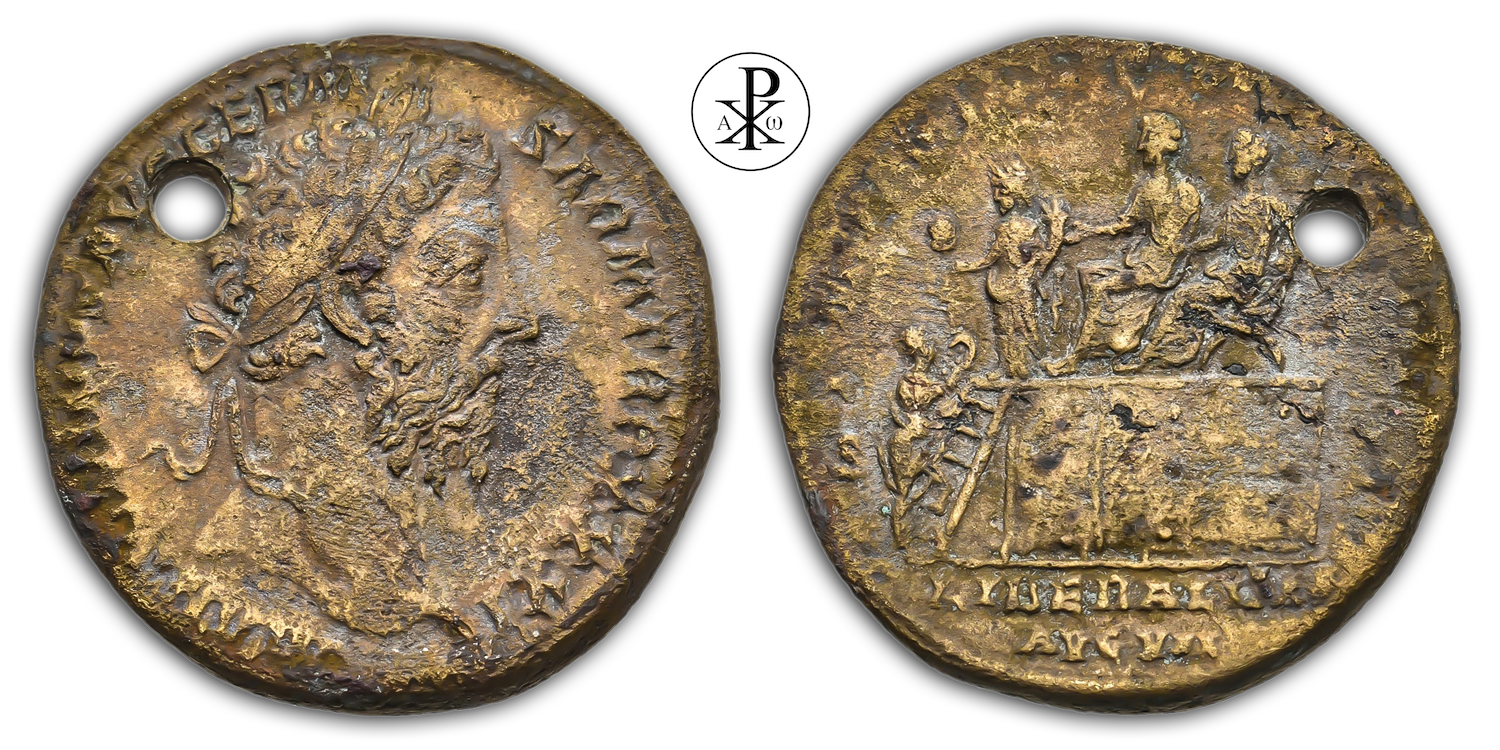Imperator Caesar Lucius Aelius Aurelius Commodus Augustus
Reign: Marcus Aurelius
Mint: Rome
Date: 176/177 AD
Nominal: Sestertius
Material: AE Bronze
Diameter: 30mm
Weight: 23.03g
Reference: RIC III Marcus Aurelius 1208
Reference: MIR 18, 380-6/30
Reference: BMCRE 1606
Reference: Cohen 424
OCRE Online: http://numismatics.org/ocre/id/ric.3.m_aur.1208
Rare: R2
Provenance: Bucephalus Numismatic Baar, Switzerland (Auction 18, Lot 397)
Pedigree: –
Obverse: Head of Marcus Aurelius, laureate, right
Inscription: M ANTONINVS AVG GERM SARM TR P XXXI
Translation: Marcus Antoninus Augustus, Germanicus, Sarmaticus, Tribunicia Potestate Prima Tricesima
Translation: Marcus [Aurelius] Antoninus Augustus, conqueror of the Germans, conqueror of the Sarmatians, holder of tribunician power for the 31st time
Reverse: Marcus Aurelius and Commodus, togate, seated left on curule chair on platform, extending right hands and left arms at sides; behind them, officer, standing left; before them, Liberalitas, draped, standing left, holding abacus in right hand and cornucopiae in left; below, citizen, togate, standing right on steps of platform, holding out fold of toga
Inscription: IMP VIII COS III P P LIBERALITAS AVG VII S C
Translation: Imperator Octavum, Consul Tertium, Pater Patriae. Liberalitas Augusti Septima, Senatus Consultum
Translation: Imperator for the eighth time, consul for the third time, father of the nation, the seventh liberality of the Augustus. Decree of the senate
Comment: In 175 AD such a decisive victory was won over the Sarmatians that Marcus Aurelius was hailed as emperor for the eighth time (IMP VIII, as also noted on this bronze) and soon afterwards took the name of the Sarmatian victor, as did his son Commodus. Now Marcus Aurelius had finally reached his goal; and he was already about to crown his hard work with the establishment of two new provinces, Marcomania and Sarmatia, when the revolt of Avidius Cassius forced him to make an early peace and set out for the East. As soon as Marcus had received the news of Cassius‘ uprising, he had his son Commodus come to the border to give him the toga virilis. Since Commodus set out for Germaniam on 19 May 175 AD and received the toga virilis at the imperial border on 7 July 175 AD, the uprising of Cassius must have taken place at the end of April or beginning of May 175 AD, and the emperor’s departure about the middle of July 175 AD. Even before the emperor came to the east, the usurper was killed and his head delivered to the emperor. The short reign of Cassius had lasted three months and six days, i.e. from about the end of April to the beginning of August. Despite the quick suppression of the Cassian uprising, Marcus, accompanied by his wife Faustina and his son Commodus, continued the journey to the East once begun. The imperial family travelled through Syria, Egypt and Cappadocia, where he lost his wife Faustina to a sudden death at the foot of the Taurus in a village called Halala (Faustinopolis?).
When Marcus Aurelius and his son Commodus sailed back from Athens to Italy about the beginning of November 176 AD, he was almost shipwrecked by a strong storm; but he landed happily at Brundisium and then entered his capital, which he had not set foot in for eight years, in the garb of peace. Immediately after his return, Marcus held (on 27 November 176 AD) a brilliant triumph de Germanis and de Sarmatis. Since then he has also been called Pater Patriae on the coins. The Tribunicia Potestate Prima Tricesima (TR P XXXI) of Marcus Aurelius, indicated on the bronze, lasted from 10 December 176 AD to 09 December 177 AD. The issue of this bronze, however, probably took place in the first weeks or months of this period, since the emperor already withdrew for some time to Lavinium to recuperate at the beginning of 177 AD; moreover, the ninth imperatorial acclamation (IMP IX) took place in the course of this year. To celebrate his happy arrival in Rome in November 176 AD, Marcus Aurelius had 200 denarii given to each citizen (Dio LXXI 32, 1) – to which the depiction on the reverse refers. The issue of this coinage, in commemoration of the emperor’s generosity, is therefore likely to be between December 176 AD and the beginning of 177 AD.
